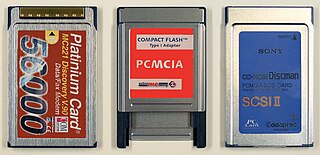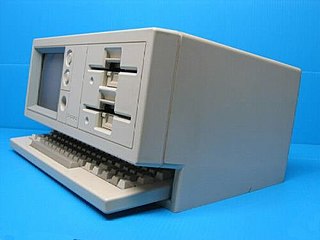Related Research Articles

PC Card is a parallel peripheral interface for laptop computers and PDAs. The PCMCIA originally introduced the 16-bit ISA-based PCMCIA Card in 1990, but renamed it to PC Card in March 1995 to avoid confusion with the name of the organization. The CardBus PC Card was introduced as a 32-bit version of the original PC Card, based on the PCI specification. The card slots are backward compatible for the original 16-bit card, older slots are not forward compatible with newer cards.
Kaypro Corporation was an American home and personal computer manufacturer based in Solana Beach in the 1980s. The company was founded by Non-Linear Systems (NLS) to compete with the popular Osborne 1 portable microcomputer. Kaypro produced a line of rugged, "luggable" CP/M-based computers sold with an extensive software bundle which supplanted its competitors and quickly became one of the top-selling personal computer lines of the early 1980s.

A portable computer is a computer designed to be easily moved from one place to another, as opposed to those designed to remain stationary at a single location such as desktops and workstations. These computers usually include a display and keyboard that are directly connected to the main case, all sharing a single power plug together, much like later desktop computers called all-in-ones (AIO) that integrate the system's internal components into the same case as the display. In modern usage, a portable computer usually refers to a very light and compact personal computer such as a laptop, subnotebook or handheld PC, while touchscreen-based handheld ("palmtop") devices such as tablets, phablets and smartphones are called mobile devices instead.

The IBM PC Convertible is a laptop computer made by IBM, first sold in April 1986. The Convertible was IBM's first laptop-style computer, following the luggable IBM Portable, and introduced the 3½-inch floppy disk format to the IBM product line. Like modern laptops, it featured power management and the ability to run from batteries.

The IBM 5100 Portable Computer is one of the first portable computers, introduced in September 1975, six years before the IBM Personal Computer, and eight before the first successful IBM compatible portable computer, the Compaq Portable. It was the evolution of a prototype called the SCAMP that was developed at the IBM Palo Alto Scientific Center in 1973. Whether considered evolutionary from SCAMP or revolutionary, it still needed to be plugged into an electric socket.

Compaq's first computers' form factors were portable, also called "luggables", and then "lunchbox computers", and together constituted the Compaq Portable series. These computers measured approximately 16 inches (410 mm) deep, 8 inches (200 mm) tall, and approximately 20 inches (510 mm) wide. As the products evolved, laptops and notebooks were created offering a new level of portability that caused the market to explode.

Computer Gaming World (CGW) was an American computer game magazine published between 1981 and 2006. One of the few magazines of the era to survive the video game crash of 1983, it was sold to Ziff Davis in 1993. It expanded greatly through the 1990s and became one of the largest dedicated video game magazines, reaching around 500 pages by 1997.

The TRS-80 Model 100 is a notebook-sized portable computer introduced in April 1983.

The Compaq Portable is an early portable computer which was one of the first IBM PC compatible systems. It was Compaq Computer Corporation's first product, to be followed by others in the Compaq Portable series and later Compaq Deskpro series. It was not simply an 8088-CPU computer that ran a Microsoft DOS as a PC "work-alike", but contained a reverse-engineered BIOS, and a version of MS-DOS that was so similar to IBM's PC DOS that it ran nearly all its application software. The computer was also an early variation on the idea of an "all-in-one".

The Hyperion is an early portable computer that vied with the Compaq Portable to be the first portable IBM PC compatible. It was marketed by Infotech Cie of Ottawa, a subsidiary of Bytec Management Corp., who acquired the designer and manufacturer Dynalogic Corporation, in January 1983. In 1984, the design was licensed by Commodore International in a move that was forecast as a "radical shift of position" and a signal that Commodore would soon dominate the PC compatible market. Despite computers being "hand-assembled from kits" provided by Bytec and displayed alongside the Commodore 900 at a German trade show as their forthcoming first portable computer, it was never sold by Commodore and some analysts downplayed the pact. The Hyperion was shipped in January 1983 at C$4995, two months ahead of the Compaq Portable.

The Compaq Deskpro is a line of business-oriented desktop computers manufactured by Compaq, then replaced by the Evo brand in 2001. Models were produced containing microprocessors from the 8086 up to the x86-based Intel Pentium 4. The Deskpro name, in an inverted fashion as "ProDesk", is still in use by HP, which Compaq merged with in 2002.

The Sharp PC-5000 was a pioneering laptop computer, announced by Sharp Corporation of Japan in November 1983. It employed a clamshell design in which the display closes over the keyboard, like the earlier GRiD Compass and contemporary Gavilan SC.
EPPC may stand for:

The history of laptops describes the efforts, begun in the 1970s, to build small, portable personal computers that combine the components, inputs, outputs and capabilities of a desktop computer in a small chassis.

A personal computer, often referred to as a PC, is a computer designed for individual use. It is typically used for tasks such as word processing, internet browsing, email, multimedia playback, and gaming. Personal computers are intended to be operated directly by an end user, rather than by a computer expert or technician. Unlike large, costly minicomputers and mainframes, time-sharing by many people at the same time is not used with personal computers. The term home computer has also been used, primarily in the late 1970s and 1980s. The advent of personal computers and the concurrent Digital Revolution have significantly affected the lives of people.

Alfaskop was a brand, developed in Sweden by Standard Radio & Telefon AB (SRT) and applied to data terminals and later IBM-compatible PCs. The term was also used to name Alfaskop AB, a listed Swedish IT services company., that filed for bankruptcy in 2001.

The Dulmont Magnum is an early laptop computer designed initially by Australian power line equipment manufacturer Dulmison Pty Ltd and subsequently marketed by Dulmont Pty Ltd. Exhibited in September 1983, it was the world's first true battery-powered laptop computer.

The HP 110 is an MS-DOS-compatible laptop released in 1984 by Hewlett-Packard. It runs off batteries and uses a Harris 80C86 running at 5.33 MHz with 272 KB of RAM. It has an 80 character by 16 line monochrome liquid crystal display, runs MS-DOS 2.11 in ROM, and has the application programs MemoMaker, Terminal Emulator and Lotus 1-2-3 in ROM.

The Sharp PC-7000 is a luggable portable computer released by Sharp Electronics in 1985. The PC-7000 was Sharp's second entry into the IBM PC-compatible portable computer market, their first being the PC-5000.

The Executive Partner is an IBM PC-compatible portable computer that was introduced by the Panasonic Corporation in 1985. The portable computer is AC-powered exclusively, weighs between 28 and 30 pounds (14 kg), and features a built-in printer. The Executive Partner was one of the first affordable portable computers with a plasma display.
References
- 1 2 PC Portables:Ericsson Portable PC, By Alfred Poor, PC Mag, 10 Dec 1985, Page 135 - 136
- 1 2 3 4 5 6 Ericsson Turns New Leaf With 15-Pound Portable, By Charles Bermant, PC Mag, 14 May 1985, Page 35
- 1 2 3 News:New Products:The Ericsson Portable PC, InfoWorld, 22 Apr 1985, Page 26
- ↑ Traveling Light, By Ron Sciblia, Popular Mechanics Feb 1986, Page 96-99 & 148